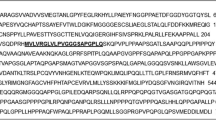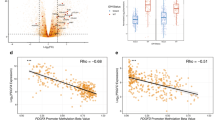Abstract
The P53N gene maps precisely to human chromosome sub-band 22q12.1-12.3, a region where loss of heterozygosity has been reported in 30% of astrocytic tumors and associated with progression to anaplasia. Moreover, a putative tumor suppressor gene has been indicated on 22q11 region involved in pathogenesis of ependymal tumors. Our objectives to examine the expression level of novel membrane-associated protein (termed P53N) encoded by a novel human gene on chromosome 22q12.1-12.3 in glioblastomas and ependymomas. Serial analysis of gene expression (SAGE) and immunofluorescence analysis of the P53N in the brain tumor tissues were performed. Our analysis revealed that there was high expression of the P53N mRNA in brain ependymoma and brain well-differentiated astrocytoma libraries. The P53N protein. P53N protein contains a high mobility group (HMG) domain at amino acid positions 301 to 360 expressed highly in glioblastoma and ependymoma specimens. Anti-P53N carboxyl-terminal peptide antibody localized the P53N protein to the cytoplasmic membranes of protoplasmic astrocytes in the glioblastoma and ependymoma specimens. These results are in good agreement with the SAGE analysis and the predicted transmembrane topology for the P53N protein and support a possible transmembrane model in which the P53N contains a predicted transmembrane region with its amino terminus localized to the inside of the cytoplasmic membrane.





Similar content being viewed by others
References
Burger PC, Vogel FS, Green SB (1985) Glioblastoma multiforme and anaplastic astrocytoma Pathologic criteria and prognostic implications. Cancer 56:1106–1111
Ekstrand AJ, Sugawa N, James CD et al (1992) Amplified and rearranged epidermal growth factor receptor genes in human glioblastomas reveal deletions of sequences encoding portions of the N- and/or C-terminal tails. Proc Natl Acad Sci USA 89(10):4309–4313
Euskirchen P, Radke J, Schmidt MS et al (2017) Cellular heterogeneity contributes to subtype-specific expression of ZEB1 in human glioblastoma. PLoS One 12(9):e0185376
Goodwin GH, Sanders C, Johns EW (1973) A new group of chromatin-associated proteins with a high content of acidic and basic amino acids. Eur J Biochem 38:14–19
Grosschedl R, Giese K, Pagel J (1994) HMG domain proteins: architectural elements in the assembly of nucleoprotein structures. Trends Genet 10(3):94–100
Hartmann C, Nümann A, Mueller W et al (2004) Fine mapping of chromosome 22q tumor suppressor gene candidate regions in astrocytoma. Int J Cancer 108(6):839–844
Hulbanni S, Goodman PA (1976) Glioblastoma multiforme with extraneural metastases in the absence of previous surgery. Cancer 37:1577–1583
Ikeda M, Arai M, Okuno T et al (2003) TMPDB: a database of experimentally-characterized transmembrane topologies. Nucleic Acids Res 31(1):406–409
Ino Y, Silver JS, Blazejewski L et al (1999) Common regions of deletion on chromosome 22q12.3-q13.1 and 22q13.2 in human astrocytomas appear related to malignancy grade. J Neuropathol Exp Neurol 58(8):881–885
Jantzen HM, Admon A, Bell SP et al (1990) Nucleolar transcription factor hUB contains a DNA-binding motif with homology to HMG proteins. Nature 344(6269):830–836
Jemal A, Thomas A, Murray T et al (2002) Cancer Statistics. CA. Cancer J Clin 52:23–47
Jennings MT, Iyengar S (2001) The molecular genetics of therapeutic resistance in malignant astrocytomas. Am J Pharmacogenomics 1(2):93–99
Kleihues P, Burger PC, Cavenee WK (1997) Glioblastoma. WHO Classification: pathology and genetics of tumors of the nervous system, 1st edn. Lyon, France, International Agency for Research on Cancers, pp 16–24
Kraus JA, de Millas W, Sörensen N et al (2001) Indications for a tumor suppressor gene at 22q11 involved in the pathogenesis of ependymal tumors and distinct from hSNF5/INI1. Acta Neuropathol 102(1):69–74
Lang FF, Miller DC, Koslow M et al (1994) Pathways leading to glioblastoma multiforme: a molecular analysis of genetic alterations in 65 astrocytic tumors. J Neurosurg 81(3):427–436
Libermann TA, Nusbaum HR, Razon N et al (1985) Amplification, enhanced expression and possible rearrangement of EGF receptor gene in primary human brain tumours of glial origin. Nature 313(5998):144–147
Louis DN, Holland EC, Cairncross JG (2001) Glioma classification: a molecular reappraisal. Am J Pathol 159(3):779–786
Louis DN, von Deimling A, Chung RY et al (1993) Comparative study of p53 gene and protein alterations in human astrocytic tumors. J Neuropathol Exp Neurol 52(1):31–38
Nakamura M, Yang F, Fujisawa H et al (2000) Loss of heterozygosity on chromosome 19 in secondary glioblastomas. J Neuropathol Exp Neurol 59(6):539–543
Nauen D, Haley L, Lin MT et al (2016) Molecular analysis of pediatric oligodendrogliomas highlights genetic differences with adult counterparts and other pediatric gliomas. Brain Pathol 26:206–214
Newcomb EW, Cohen H, Lee SR et al (1998) Survival of patients with glioblastoma multiforme is not influenced by altered expression of p16, p53, EGFR, MDM2 or Bcl-2 genes. Brain Pathol 8(4):655–667
Newcomb EW, Madonia WJ, Pisharody S et al (1993) A correlative study of p53 protein alteration and p53 gene mutation in glioblastoma multiforme. Brain Pathol 3(3):229–235
Nigro JM, Baker SJ, Preisinger AC et al (1989) Mutations in the p53 gene occur in diverse human tumour types. Nature 342(6250):705–708
Riemenschneider MJ (2009) Reifenberger G. Molecular neuropathology of gliomas. Int J Mol Sci 10:184–212
Smith JS, Tachibana I, Lee HK et al (2000) Mapping of the chromosome 19 q-arm glioma tumor suppressor gene using fluorescence in situ hybridization and novel microsatellite markers. Genes Chromosomes Cancer 29(1):16–25
Surawicz TS, Davis F, Freels S et al (1998) Brain tumor survival: results from the National Cancer Data Base. J Neurooncol 40:151–160
Ueki K, Ono Y, Henson JW, Efird JT et al (1996) CDKN2/p16 or RB alterations occur in the majority of glioblastomas and are inversely correlated. Cancer Res 56(1):150–153
von Deimling A, Eibl RH, Ohgaki H et al (1992) p53 mutations are associated with 17p allelic loss in grade II and grade III astrocytoma. Cancer Res 52(10):2987–2990
von Deimling A, Louis DN, von Ammon K et al (1992) Association of epidermal growth factor receptor gene amplification with loss of chromosome 10 in human glioblastoma multiforme. J Neurosurg 77(2):295–301
Wang C, McCarty IM, Balazs L et al (2002) A prostate-derived cDNA that is mapped to human chromosome 19 encodes a novel protein. Biochem Biophys Res Commun 296:281–287
Watanabe K, Sato K, Biernat W et al (1997) Incidence and timing of p53 mutations during astrocytoma progression in patients with multiple biopsies. Clin Cancer Res 3(4):523–530
Watanabe K, Tachibana O, Sata K et al (1996) Overexpression of the EGF receptor and p53 mutations are mutually exclusive in the evolution of primary and secondary glioblastomas. Brain Pathol 6(3):217–223
Wong AJ, Ruppert JM, Bigner SH et al (1992) Structural alterations of the epidermal growth factor receptor gene in human gliomas. Proc Natl Acad Sci USA 89(7):2965–2969
Acknowledgements
We thank Chiang Wang, Ph.D., for assisting Dr. Bruce M. Frankel. We also thank Sigma Genosys for the generation of the anti-P53N carboxyl-terminal peptide antibody.
Funding
This study was partially supported in part by the NIH sponsored grants to Bruce M. Frankel (1R01FD003542-01), Departments of Neurosurgery and Urology at the University of Tennessee Health Science Center, the Assisi Foundation of Memphis, and a grant from the American Brain Tumor Association (to BMF).
Author information
Authors and Affiliations
Contributions
Conceived and designed the experiments: BMF. Analyzed the data: BMF. Wrote the draft of the manuscript: BMF, AD, and DC. Contributed to the writing of the manuscript: BMF, AD, SJP, and DC (all authors). Agree with manuscript results and conclusions: all authors. Jointly developed the structure and arguments for the paper: all authors. Made critical revisions and approved final version: BMF. All authors reviewed and approved of the final manuscript.
Corresponding author
Ethics declarations
Ethics Approval and Consent to Participate
All participants signed informed consent. Subjects gave their written, informed consent to participate.
Conflict of Interest
The authors declare that they have no conflict of interest.
Additional information
Publisher’s Note
Springer Nature remains neutral with regard to jurisdictional claims in published maps and institutional affiliations.
Rights and permissions
About this article
Cite this article
Frankel, B.M., Cachia, D., Patel, S.J. et al. Analysis of the P53N a Novel Protein Encoded on Chromosome 22q12.1-12.3 in Glioblastomas and Ependymomas Specimens. J Mol Neurosci 71, 1714–1722 (2021). https://doi.org/10.1007/s12031-021-01808-8
Received:
Accepted:
Published:
Issue Date:
DOI: https://doi.org/10.1007/s12031-021-01808-8




